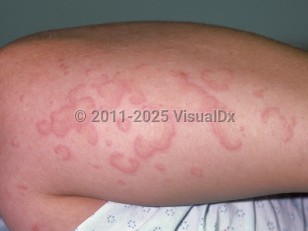Urticarial vasculitis in Adult
Alerts and Notices
Important News & Links
Synopsis

The lesions of urticarial vasculitis must be distinguished from those seen in acute and chronic urticaria. In contrast to the itch that predominates in acute and chronic urticaria, the plaques of urticarial vasculitis are often described as having a burning or painful sensation with mild itch. Additionally, each plaque in urticarial vasculitis persists for more than 24 hours and leaves behind residual hyperpigmented discoloration as it resolves. In contrast, each wheal of acute and chronic urticaria generally resolves within 24 hours and without residual discoloration.
Urticarial vasculitis is thought to represent a type III immune reaction with deposition of circulating immune complexes. It may be idiopathic in origin or may be precipitated by infections, medications, or neoplasms, and may be associated with connective tissue disease or paraproteinemia.
Complement levels in urticarial vasculitis may either be normal (normocomplementemic form) or low (hypocomplementemic form). While both forms can be associated with systemic symptoms including arthralgia (most common), the hypocomplementemic form is most commonly associated with more pronounced systemic involvement including pulmonary, ocular, gastrointestinal (GI), renal, and cardiac findings. Progressive chronic obstructive pulmonary disorder has been noted in hypocomplementemic urticarial vasculitis, particularly in smokers. There are also reports of bibasilar panacinar emphysema in these patients. Controversy exists as to the relationship between hypocomplementemic urticarial vasculitis and systemic lupus erythematosus (SLE), with some authors arguing that they are related disorders, or even potentially along one spectrum of disease.
Urticarial vasculitis can occur at any age, although it is most frequently noted in women in the fifth decade. It is rare in children; however, cases of both normocomplementemic and hypocomplementemic urticarial vasculitis have been reported. When hypocomplementemic urticarial vasculitis is seen in children, it is often associated with renal involvement.
Prognosis for urticarial vasculitis is generally noted to be positive, although outcomes largely depend on the presence of any associated or underlying disease. Rarely, marked renal involvement has been seen with hypocomplementemic urticarial vasculitis, more frequently in children than in adults. Additionally, there is one case report describing pulmonary hemorrhage in a child with urticarial vasculitis.
Codes
L95.9 – Vasculitis limited to the skin, unspecified
SNOMEDCT:
402656007 – Urticarial vasculitis
Look For
Subscription Required
Diagnostic Pearls
Subscription Required
Differential Diagnosis & Pitfalls

Subscription Required
Best Tests
Subscription Required
Management Pearls
Subscription Required
Therapy
Subscription Required
Drug Reaction Data
Subscription Required
References
Subscription Required
Last Updated:11/25/2018

